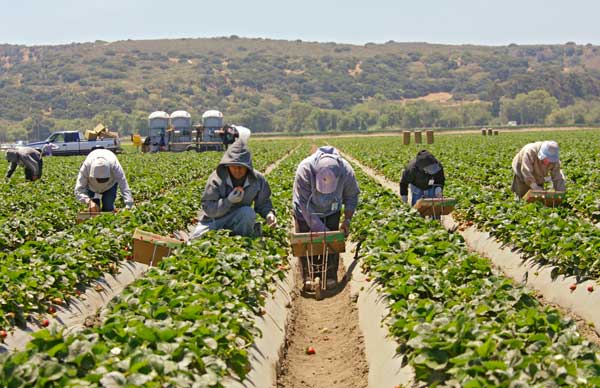 It’s always blue skies for the agrichemical industry Monsanto rolled out seeds genetically engineered to withstand its Roundup herbicide back in the mid-1990s. Today, Roundup Ready crops blanket U.S. farmland. According to USDA figures, 90 percent of soybeans and 60 percent of corn and cotton planted in the United States contain the Roundup-resistant gene.
It’s always blue skies for the agrichemical industry Monsanto rolled out seeds genetically engineered to withstand its Roundup herbicide back in the mid-1990s. Today, Roundup Ready crops blanket U.S. farmland. According to USDA figures, 90 percent of soybeans and 60 percent of corn and cotton planted in the United States contain the Roundup-resistant gene.
Back-of-the envelope calculations tell me that total land devoted to Roundup Ready crops equals nearly 200,000 square miles — about two-thirds the size of Texas.
Roundup Ready’s conquest of U.S. farmland has been an unmitigated boon for Monsanto shareholders. Not only could the company charge a fat premium for its biotech seeds, but sales of the Roundup herbicide surged. By 2008, Monsanto was clocking more than $1 billion annually in profit from Roundup sales alone.
For years, Monsanto presented its economic triumph as an environmental gift to humanity. According to company talking points, the sudden ubiquity of Roundup, whose active ingredient is a chemical called glyphosate, eliminated the need to use other, more toxic herbicides. Moreover, Roundup Ready technology allows farmers to control weeds without having to till, dramatically reducing soil erosion.
Now, however, the Roundup juggernaut has run off course. Roundup’s status as ecologically benign is turning to dust. A study by France’s University of Caen last year found that the herbicide’s allegedly “inert” ingredients magnify glyphosate’s toxic effects. According to the study, “the proprietary mixtures available on the market could cause cell damage and even death” at levels commonly used on farm fields.
The annual cascade of Roundup on vast swaths of prime farmland also appears to be undermining soil health and productivity, as this startling recent report cited by Tom Laskawy shows.
Meanwhile, the endlessly repeated claim that Roundup Ready technology saves “millions of tons” of soil” from erosion appears to be wildly trumped up. According to Environmental Working Group’s reading of the USDA’s 2007 National Resource Inventory, “there has been no progress in reducing soil erosion in the Corn Belt since 1997.” (The Corn Belt is the section of the Midwest where the great bulk of Roundup Ready corn and soy are planted.) “The NRI shows that an average-sized Iowa farm loses five tons of high quality topsoil per acre each year,” EWG writes.
Finally, there’s the ecological liability that will likely doom Roundup Ready’s dominance of U.S. farmland. It’s perhaps the least surprising, most-anticipated major development in the history of U.S. agriculture: After years of annually dousing millions of acres of farmland with a single herbicide, farmers are finding that certain weeds have developed resistance to that herbicide.
Reports of Roundup-defying “superweeds” have circulated for years. The Union of Concerned Scientists has has been expressing concern about them since 2001 if not before. By last summer, the issue was causing serious consternation among large-scale farmers, especially in southern cotton country. In late 2009, a report from the Organic Center (PDF) showed that farmers were dramatically boosting Roundup application rates in a desperate attempt to control ever-hardier weeds.
“The average annual increase in the pounds of glyphosate applied to cotton, soybeans, and corn has been 18.2%, 9.8%, and 4.3%, respectively, since HT [herbicide-tolerant] crops were introduced,” the report showed.
As application rates have ramped up, the superweed menace has become so obvious the mainstream press has taken notice. “Superweeds Hit Farm Belt, Triggering New Arms Race,” declares a Wall Street Journal headline from last week. The article documents a trend I’ve been writing about since last year: Rather than spark a reassessment of the wisdom of relying on toxic chemicals, the failure of Roundup Ready has the U.S. agricultural establishment scrambling to intensify chemical use.
The Journal reports that Dow Chemical, DuPont, Bayer, BASF, and Syngenta are “together spending hundreds of millions of dollars to develop genetically modified soybean, corn, and cotton seeds that can survive a dousing by their herbicides,” most of which are “many decades old” and highly toxic. Dow AgroSciences, for example, is viewing the collapse of Roundup Ready as an opportunity to revive use of 2,4-D, which the Journal describes as a “powerful herbicide introduced nearly 65 years ago.” 2,4-D is indeed vile stuff — Pesticide Action Network lists it as a “bad actor.” But rather than phase it out, Dow “hopes by 2013 to be selling seeds for corn crops that will be unaffected if farmers splash 2,4-D on their fields,” the Journal reports.
Meanwhile, Monsanto hardly plans to surrender the lucrative GMO seed/pesticide market to its rivals. For one, it’s developing a line of GMO soybeans resistant to the highly toxic herbicide dicamba, the Journal reports. Dicamba, too, is a Pesticide Action Network “bad actor.” For another, it’s working on “next-generation” biotech seeds that can withtand other herbicides along with Roundup. I hate to imagine the “thug weeds” that will evolve to withstand such herbicide cocktails.
In another words, Roundup Ready technology didn’t bring the war between herbicides and weeds to a draw, as Monsanto claimed it would; instead, it has escalated that war. What ecologists call the pesticide treadmill has accelerated — to the delight of the agrichemical industry and the detriment of the land, farmers, and consumers.
Industry execs don’t even try to hide their glee. “The herbicide business used to be good before Roundup nearly wiped it out,” a Syngenta told the Journal. “Now it is getting fun again.”
In a better world, farmers would be looking to non-chemical methods for controlling weeds: crop rotations, mulching, cover crops, etc. The USDA’s research arm, the National Institute of Food and Agriculture (NIFA), would be scrambling to help farmers develop appropriate, non-toxic technologies for controlling weeds.
In reality, however, President Obama tapped agrichemical-friendly Roger Beachy to run NIFA last year. Beachy came to NIFA after years at the St. Louis-based biotech research institute the Danforth Center — which launched with Monsanto cash and has maintained a tight association with the seed/agrichemical giant. When I met Beachy at a conference in Mexico last February, he expressed open contempt for organic ag and referred to GMOs with the industry’s favored phrase: “improved crops.”
With friends like that, it’s no wonder that the agrichemical industry can spin failures like Roundup Ready into the next marketing opportunity.




